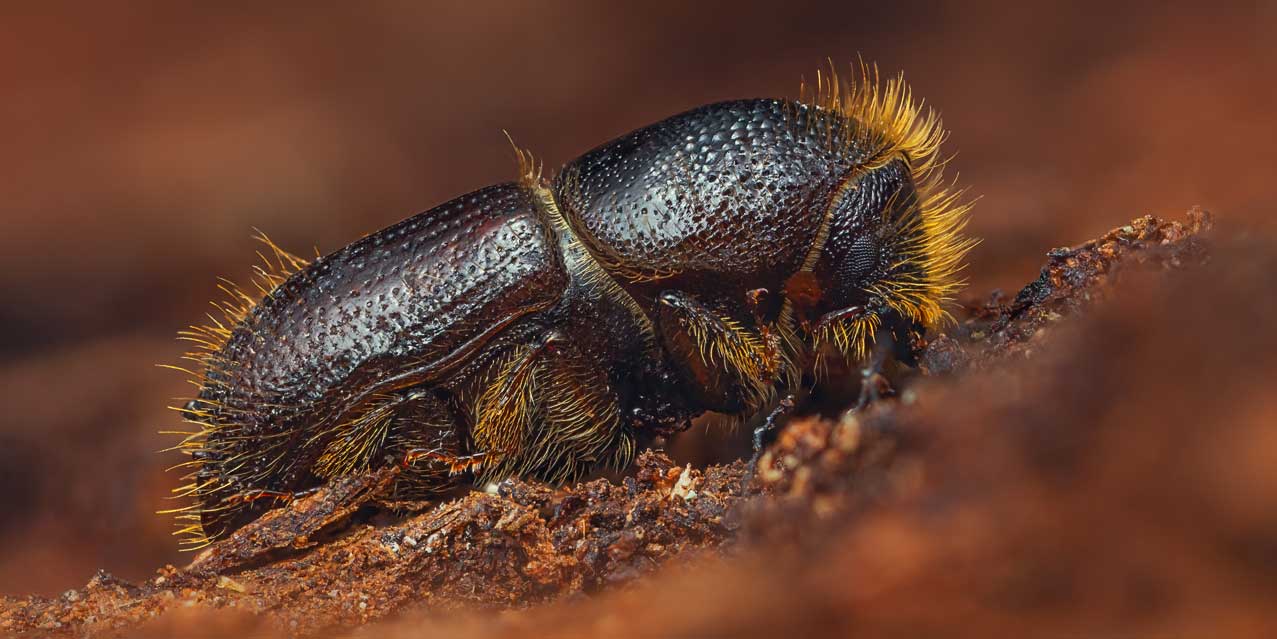5 min read
Latvian State of Emergency: Eight-Toothed Spruce Bark Beetle Threatens Forests
 Angela Rockwell
:
May 17, 2023 12:00:00 AM
Angela Rockwell
:
May 17, 2023 12:00:00 AM

Latvian forests are facing a grave crisis as they are being plagued by an infestation of eight-toothed spruce bark beetles (Ips typographus). The scale of destruction has skyrocketed, with an estimated 2,300 hectares (more than 5,600 acres) of spruce forest affected in 2022 alone. In response to this escalating threat, the Latvian government declared a state of emergency in 32 regions effective from April 1st to June 30th.
The Spread of Ips Typographus
Not to be confused with the mountain pine beetle ravaging Canadian forests since the early 1990s, the eight-toothed spruce bark beetle predominantly targets spruce trees. This beetle species is found in most of continental Europe as well as parts of Asia and Africa. Favorable weather conditions—mild winters and hot summers with little rainfall—have contributed to the rapid population growth and spread of Ips typographus in Latvia over the past two years.
These beetles are particularly attracted to the volatile organic compounds emitted by stressed, weakened, and freshly cut spruce trees, making them more susceptible to infestation. Once the initial infestation occurs, the spruce bark beetles tend to expand their presence to healthy surrounding trees, even spreading to pine trees if their population becomes large enough.
Recognizing the Signs of Eight-Toothed Spruce Bark Beetle Damage
Identifying the damage caused by the eight-toothed spruce bark beetle is crucial for detection and effective management. Depending on the severity of the attack, along with factors such as temperature and moisture conditions, noticeable signs can occur as early as one month or up to two years after an attack. Here are some key symptoms to look out for:
-
The upper canopy of infested trees may exhibit a noticeable browning, serving as an early warning sign.
-
The needles of affected trees may become lighter and form mats. These mats often detach from the tree and accumulate on the ground.
-
Small entrance holes, measuring about 2–2.5mm in diameter, on the surface of the tree's bark can also be a telltale sign. These holes result from the beetles burrowing into the tree to lay their eggs and establish galleries.
-
Frass—the sawdust-like waste material produced by the feeding larvae of the spruce bark beetles—may be present on tree bark at the base of branches and trunks.
-
Peeled or missing bark can be a sign of woodpecker activity. Woodpeckers are natural predators of spruce bark beetles and actively search for larvae in infested trees. The birds may cause additional damage by breaking off bark sections on attacked stems to access the larvae.

Protecting Latvian Spruce Forests
Latvia is known for its abundant woodlands, filled with tree species such as oak, aspen, pine, birch, and spruce. Spanning more than 50 percent of the country's landscape, forests hold ecological and economic significance in Latvia. In fact, forestry and woodworking make up about 20 percent of the country's exports.
The government's approval of the Ministry's order for the declaration of a state of emergency on March 28th signifies the seriousness of the situation. According to a Baltic News Network (BNN) article, the Latvian Ministry of Agriculture, in collaboration with the State Forest Service, Latvian State Institute of Forestry Silava, and other stakeholders, has implemented a range of restrictions on forestry-related economic activity in an effort to safeguard the spruce forests at risk.
As part of the state of emergency, the Ministry has established protected zones in which stringent rules will be enforced. Tree felling will be prohibited or extremely limited except for trees already affected by spruce bark beetles, and even then, it must adhere to stringent regulations. Even more, the felling and removal of already damaged trees will only be allowed with the express approval of the State Forest Service.
The BNN article goes on to state that "to ensure immediate implementation of measures during the state of emergency, the State Forests Service will issue special felling permits. These permits will remain valid for two months."
Kai Merivouri, the Managing Director of Merivouri Consulting Ltd, explains, "The aim is to steer sanitation and normal harvesting activities to freshly infested plots and their surroundings to protect healthy spruce forests from the infestation."

Further Impacts on European Forests
Before the situation in Latvia, spruce bark beetles had already caused severe damage in Western and Central Europe. After an infestation was discovered in Kent, England, in 2018, the UK Forestry Commission issued guidance to "landowners, managers, and timber processors [to] remain vigilant of Ips typographus, and…continue taking the necessary action to rapidly remove storm damaged trees in their area."
Ips typographus infestations have threatened the Białowieża Forest, a vast and ancient woodland located on the border between Belarus and Poland. Spruce bark beetles have also wreaked havoc on other Central European countries, including Germany, Austria, Slovenia, and the Czech Republic.
The widespread effect of this pervasive pest is expected to lead to reductions in the annual allowable cut (AAC) in Central Europe and potentially in Nordic countries, thereby causing notable economic impacts.
Stopping the Spread of Spruce Bark Beetles
There are several actions that government entities and landowners have taken to mitigate the spread of spruce bark beetles.
Specific mitigation measures may vary depending on the region, the severity of the infestation, and local ecological conditions. Consulting with forestry experts, entomologists, or relevant authorities will provide crucial guidance for developing effective strategies to mitigate the spread of Ips typographus.
Examples of mitigation measures include:
-
Early detection and monitoring: Implement a robust monitoring system to detect the presence of Ips typographus in forested areas. Regularly inspect trees for signs of infestation. Early detection allows for prompt intervention and containment efforts.
-
Removal of infested trees: Identify and remove infested trees promptly to prevent the beetles from spreading to healthy trees. Focus on removing heavily infested or dying trees, as they act as breeding grounds and sources of beetles for further infestation.
-
Sanitation measures: Implement sanitation measures to limit the spread of the beetles. These involve removing and destroying infested materials, such as fallen trees, branches, and bark, as they can harbor beetle populations. Proper disposal methods should be followed, including chipping, burning, or burying the infested materials.
-
Forest management practices: Promote good forest management practices to maintain tree health and reduce vulnerability to Ips typographus infestation. These include proper thinning, pruning, and removing weak or stressed trees, which are more susceptible to attack.
-
Protection zones: Establish protected zones around areas where Ips typographus has been detected. Limit or restrict human activities within these zones, such as logging or transportation of infested materials, to prevent further spread.
-
Use of pheromone traps: Deploy pheromone traps, which emit specific scents to attract and trap Ips typographus beetles. These traps can help monitor beetle populations and provide an early warning system for infestations.
-
Biological control: Explore the use of natural enemies, such as parasitic wasps or predators, as biological control agents to suppress Ips typographus populations. This approach requires careful consideration and should be implemented in consultation with entomology and forest ecology experts.
-
Public awareness and education: Raise awareness among forest owners, workers, and the public about the risks and consequences of Ips typographus infestation. Promote responsible forest management practices and encourage reporting of suspected infestations to facilitate swift action.
The infestation of eight-toothed spruce bark beetles in Latvian forests and other parts of Europe poses a significant threat to ecosystems and the forestry industry. Effective measures must be implemented to safeguard ecologically and economically valuable forests and ensure their long-term health and sustainability.
"We must prioritize preventing the further spread of these beetles to protect our valuable spruce forests," emphasizes Merivouri. "Maintaining the health and growth of forests through well-planned harvesting practices can help achieve this goal."
Sources
“Beetles Are Ravaging Europe’s Oldest Forest. Is Logging the Answer?” Science. Accessed May 15, 2023. https://www.science.org/content/article/beetles-are-ravaging-europe-s-oldest-forest-logging-answer.
“Eight-Toothed Spruce Bark Beetle Emergency in Latvia.” LSM, February 9, 2023. https://eng.lsm.lv/article/society/environment/eight-toothed-spruce-bark-beetle-emergency-in-latvia.a495556/.
“Eight-Toothed Spruce Bark Beetle (Ips Typographus).” Woodland Trust. Accessed May 15, 2023. https://www.woodlandtrust.org.uk/trees-woods-and-wildlife/tree-pests-and-diseases/key-tree-pests-and-diseases/eight-toothed-spruce-bark-beetle/.
"Larger Eight-Toothed European Spruce Bark Beetle (IPS Typographus).” Forest Research, August 10, 2022. https://www.forestresearch.gov.uk/tools-and-resources/fthr/pest-and-disease-resources/larger-eight-toothed-european-spruce-bark-beetle-ips-typographus.
“Latvia - Forestry/Woodworking.” International Trade Administration | Trade.gov. Accessed May 16, 2023. https://www.trade.gov/country-commercial-guides/latvia-forestrywoodworking.
Milton, Matt. “Latvia Introduces Emergency Measures to Stop Spread of Bark Beetle.” Timber Development UK, April 25, 2023. https://timberdevelopment.uk/latvia-introduces-emergency-measures-to-stop-spread-of-bark-beetle/.
“Mountain Pine Beetle.” Natural Resources Canada, April 14, 2022. https://natural-resources.canada.ca/our-natural-resources/forests/wildland-fires-insects-disturbances/top-forest-insects-and-diseases-canada/mountain-pine-beetle/13381.
“To Limit Damages Caused by Spruce Bark Beetles, Latvia Declares State of Emergency in 32 Regions.” Baltic News Network, March 28, 2023. https://bnn-news.com/to-limit-damages-caused-by-spruce-bark-beetles-latvia-declares-state-of-emergency-in-32-regions-244367.




